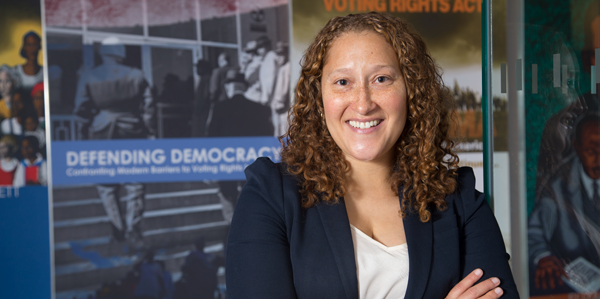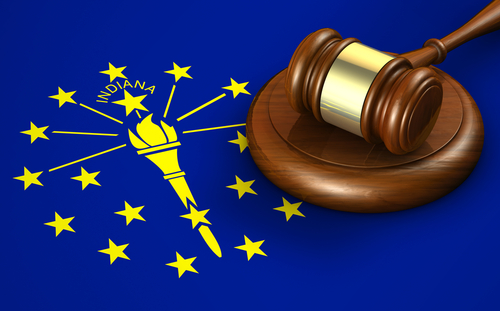Appeals courts are dismantling stricter voter ID laws

Illustration by Stephen Webster
A strict voter identification law in Texas—blocked. A North Carolina law that required voter ID, which reduced early voting and changed registration procedures—struck down for not only having discriminatory effects but also for having been passed with a racially discriminatory motive. North Dakota’s voter ID law—blocked because of bias toward Native Americans.
Under an election law in Wisconsin, one federal district judge ordered an affidavit procedure for those without ID; days later, another district judge struck down provisions that limit early voting and increase residency requirements.
The string of recent rulings deals serious blows to measures advanced by many Republicans in the name of election integrity, while others view them as discriminatory.
The rulings indicate that “there is a limit in how far states can go in rolling back voting rights before the courts are going to step in,” says Richard L. Hasen, a professor of law and political science at the University of California at Irvine School of Law and the founder of the authoritative Election Law Blog.
“Still, this is an ongoing battle,” he says. “The one thing we know for certain is these battles won’t be over when the 2016 election is decided. They will go beyond that.”
Kristen Clarke, the president and executive director of the Lawyers’ Committee for Civil Rights Under Law, a Washington, D.C.-based nonprofit that opposes strict voter ID and similar restrictions, says courts are starting to see these measures for what they are.
“These are not measures aimed at combating fraud or preserving the integrity of the election process,” she says. “These are laws that attempt to make it more difficult for certain kinds of voters to participate, particularly African-Americans and Latinos.”
Hans A. von Spakovsky, a senior legal fellow and the manager of the Election Law Reform Initiative at the Heritage Foundation in Washington, D.C., has a less enthusiastic reaction to the spate of decisions.
“I don’t use the word absurd lightly, but I think it applies to some of these decisions,” says von Spakovsky, a former federal elections official and Department of Justice lawyer who has long advocated for strict voter ID and other election-protection measures. “What I do believe is going on is that the challengers, their lawyers and some of these judges are gaming the system.”
MORE TO THE POLLS
The more immediate effects of the rulings were debated on the campaign trail.
Sen. Tim Kaine, the Virginia Democrat who is Hillary Clinton’s vice presidential running mate, says the effect of the ruling by the 4th U.S. Circuit Court of Appeals at Richmond, Virginia, striking down North Carolina’s voter ID law (and other provisions) could lead to an additional 100,000 people going to the polls in that state this month.
In late August, a divided U.S. Supreme Court rejected a request from North Carolina to overturn the appeals court ruling and bring back the voter ID requirement, reduce the number of early voting days, and end a preregistration program for young voters. The high court’s one-page order provided no explanation, but the justices split 4-4 along their traditional ideological lines, with the conservatives indicating they would grant the stay with respect to most of the challenged provisions.
North Carolina is a presidential battleground that President Barack Obama won in 2008 but Mitt Romney, then the Republican nominee, won in 2012. The race was decided by fewer than 100,000 votes out of more than 4.3 million cast each election.
Republican presidential nominee Donald Trump decried the string of court rulings that block voter ID laws, saying in August that it would lead to a “rigged” election in which some people may vote 10 times. He later upped that prediction to 15 times.
“Why not?” Trump said in an August interview with the Washington Post. “If you don’t have voter ID, you can just keep voting and voting and voting.”
That is a scenario most election experts say is not plausible, and several of the court rulings on voter ID laws addressed whether a problem of voter impersonation was a significant interest supporting such laws at all.
Besides citing a mound of expert evidence, the recent court rulings related a series of personal stories of those unable to vote because of ID laws that created unusual hardships. The 5th Circuit at New Orleans cited the troubles of Floyd Carrier, an 85-year-old Texas retiree who was born at home and who, with help from his son, contacted three counties to try to obtain a birth certificate needed to get proper ID to vote. Although he was known to election workers at his polling place, he was not permitted to vote and not even provided a provisional ballot.
In North Dakota, a federal district judge cited the case of Richard Brakebill, who was denied the right to vote in 2014 because he had an expired driver’s license and a tribal ID that did not have his current residential address. He had tried to update his driver’s license but lacked his birth certificate.
In Wisconsin, a federal district judge cited the case of a voter he called “Mrs. Smith,” who was born in 1916 and petitioned the state’s Division of Motor Vehicles for help to track down her birth certificate to get the state ID she needed to vote. State employees were able to find her name in the 1930 U.S. census, but they couldn’t link that to a birth certificate in Missouri, where Smith was born.
“Because she was born in the South, barely 50 years after slavery, her story is particularly compelling,” the judge wrote. “But it is not unique.”
SETTING THE STAGE
Two Supreme Court decisions laid the foundation for the raft of voter ID laws and other election measures passed by the states in recent years.

Hans Von Spakovsky. Photograph by David Hills.
In 2008, in Crawford v. Marion County Election Board, the high court issued a fractured 6-3 judgment that upheld Indiana’s voter ID law against a 14th Amendment constitutional challenge that it unfairly burdened the right to vote.
Justice John Paul Stevens wrote a plurality opinion that concluded the record in the case did not support a facial challenge to the Indiana law, which was one of the first voter ID laws adopted in the country. Earlier this year, at the 7th Circuit judicial conference, now-retired Stevens called Crawford “a fairly unfortunate decision” but said he thought he would vote the same way in the case, again based on the record the court had before it.
Meanwhile, the Supreme Court’s 2013 decision in the Alabama case Shelby County v. Holder opened the door for the adoption of more voter ID measures.
That decision struck down Section 4 of the Voting Rights Act of 1965, which established the coverage formula for the separate provision—Section 5—that required states and localities with a history of discrimination in voting to gain federal approval of changes in voting, which includes redistricting efforts and election procedures.
Once such covered states no longer had to submit to the federal “preclearance” process, several moved quickly to adopt voter ID and other measures.
“Very few cases would even be here but for the Supreme Court’s gutting of the Voting Rights Act” in the Shelby County decision, says Denise Lieberman, a senior attorney with the Advancement Project, a Washington, D.C.-based civil rights organization that led the challenge to the North Carolina law.
Edward Blum, the retired stockbroker and former unsuccessful candidate for Congress who organized the legal assault on the Voting Rights Act in Shelby County, says he was somewhat surprised to see the strict voter ID regulations take hold in more than 30 states after the Supreme Court decision.
Blum says his main interest in organizing the challenge to the coverage formula of the Voting Rights Act was his opposition to racially gerrymandered districts. “For the most part, I’m right down the middle” on voter ID laws, he says. “I think there should be some form of voter ID. Nearly every Western country requires some form of it. On the other hand, some of the requirements may be too stringent.”
The string of recent rulings gave election law experts and others plenty to chew on.
making a way in texas
On July 20, the full 5th Circuit got the ball rolling on the summer’s rulings with a lengthy decision about Texas’ voter ID law.
The 5th Circuit ruled 9-6 that the Texas law has a racially discriminatory effect on African-American and Latino voters, in violation of Section 2 of the Voting Rights Act. The court ordered a federal district judge to come up with a remedy for the presidential election.
The Texas law is notable for the types of identification considered acceptable, which included valid state driver’s licenses and identification cards, U.S. passports and citizenship documents, an “election identification certificate” or a Texas license to carry a concealed weapon.

Kristen Clarke. Photograph by David Hills.
Those potential voters who apply for the election ID certificate, which was designed to serve those who could not obtain acceptable forms of ID, still had to have a birth certificate. Some had to drive up to 250 miles to the nearest state Department of Public Safety office to apply for the certificate. By this spring, the state had issued only about 650 certificates.
In 2014, a federal district court struck down the state’s application of the voter ID law, holding that a dispropor-tionate share of about 600,000 registered voters and1.2 million eligible voters in the state who lacked the requisite forms of identification were black or Latino. (The Supreme Court, over a dissent by Justice Ruth Bader Ginsburg that was joined by Justices Sonia Sotomayor and Elena Kagan, backed a stay that allowed the law to remain in effect for the 2014 midterm elections.)
The 5th Circuit, in its July ruling in Veasey v. Abbott, upheld the “discriminatory effects” finding and ordered the district court to consider whether state lawmakers had acted with discriminatory intent. But it said the latter question could be addressed after the presidential election. In the short term, the appeals court required the district judge to establish a procedure for those who lacked the proper documentation to be able to cast ballots on Nov. 8.
Judge Edith H. Jones, writing for the dissenters, said, “Requiring a voter to verify her identity with a photo ID at the polling place is a reasonable requirement widely supported by Texans of all races and members of the public belonging to both political parties.” The majority’s suggestion that the measure was enacted with discriminatory purpose was “inflammatory and unsupportable,” she said.
In August, a federal district judge in Corpus Christi, Texas, approved a settlement agreed to by state officials that voters without the state-approved ID should be able to sign a declaration that they faced “reasonable impediments” in obtaining one.
Those voters must be allowed to cast a regular ballot after they show an alternative form of ID, such as a voter registration card, utility bill or other form of government ID that’s not on the state’s list.
“It looks like there will be an avenue for those without acceptable photo ID,” says Leah Aden, senior counsel with the NAACP Legal Defense and Educational Fund, which was among the groups behind a challenge to the Texas statute.
changes in North Carolina
The day after the Supreme Court decided Shelby County in 2013, and North Carolina no longer had to gain federal approval for its changes in voting, Republicans who had become the new majority in the state legislature announced plans for an omnibus bill that overhauled election procedures.
Before proceeding with that bill, lawmakers requested data on the use, by race, of a number of voting practices in the state. The General Assembly then enacted legislation that restricted voting and registration in five different ways, all of which disproportionately affected African-Americans.
Besides requiring strict photo ID (and eliminating many alternative forms of identification found to be used heavily by African-Americans), the bill that passed eliminated same-day voter registration, reduced the early voting period from 17 to 10 days (thus canceling one of two “souls to the polls” Sundays promoted in black churches), and ended provisional voting for out-of-precinct voters and preregistration for 16- and 17-year-olds in the state.
Amid the initial legal battles in the challenge to the law, North Carolina lawmakers passed a bill that amended the photo ID requirement to allow those without acceptable ID to declare that they faced a “reasonable impediment” to getting such ID. A federal district court then conducted separate trials on most of the voting changes in one and on the revised ID measure in the other.
On the merits, the judge ruled against the plaintiffs and upheld all of North Carolina’s changes.

Leah Aden. Photograph by Arnie Adler.
It was a different story before a three-judge panel of the 4th Circuit, which unanimously struck down the changes on July 29. The court held that the provisions were enacted with racially discriminatory intent in violation of the equal protection clause of the 14th Amendment and Section 2 of the Voting Rights Act.
“The new provisions target African-Americans with almost surgical precision,” wrote Judge Diana Gribbon Motz for the panel in North Carolina State Conference of the NAACP v. McCrory, “… and, in fact, impose cures for problems that did not exist. Thus, the asserted justifications cannot and do not conceal the state’s true motivation.”
(The panel ruled 2-1 that the reasonable-impediment change to the photo ID law did not cure the discrimi-natory intent violation for that provision. Thus, it fully voided the ID provision, along with the several other provisions at issue.)
“The 4th Circuit is saying here that context and history matter,” says Lieberman of the Advancement Project, one of the groups behind the challenge to the North Carolina measures. “It matters that [the state] did all this stuff without any real government interest.”
Republican lawmakers vowed to appeal, saying the decision was a partisan one by three judges appointed by Democratic presidents.
“Photo IDs are required to purchase Sudafed, cash a check, board an airplane and even vote at the most recent Democratic convention,” wrote Republican Gov. Pat McCrory in an August essay in USA Today after the decision. “North Carolina implemented this commonsense measure to maintain the integrity of honest and fair elections and joins more than 30 other states that require an ID to vote.”
When the U.S. Supreme Court divided 4-4 on North Carolina’s request for an emergency stay to reinstate its provisions on Aug. 31, most observers saw it as a sign that it was unlikely the eight-member court would undo the recent appeals court decisions against voter ID laws before this year’s election.
“In the interim, this really empowers the lower courts, both the federal courts of appeals and the state supreme courts” on pending voting rights cases, said law professor Hasen in an Aug. 31 post on Election Law Blog.
‘LESSER OF TWO EVILS’ IN WISCONSIN
Two different federal district judges issued rulings in July regarding voting practices in Wisconsin; and by August, the 7th Circuit at Chicago had gotten involved in one of the cases.
On July 19, Judge Lynn Adelman of Milwaukee issued an order that said Wisconsin voters who had difficulty obtaining the specified forms of photo ID still would be able to vote by filing an affidavit at the polling place.
Sean J. Young, a senior staff attorney with the American Civil Liberties Union, which is backing the challenge in that case, says the affidavit option, which would allow voters without ID to cast regular ballots and not provisional ones, was “the lesser of two evils.”
“Provisional ballots are extremely confusing to voters and even to election workers,” Young says. “There’s no guarantee they will be counted. We thought it was important that these votes not be treated like [they were cast by] second-class citizens.”
On July 29, U.S. District Judge James D. Peterson of Madison ruled in a broader lawsuit in One Wisconsin Institute v. Thomsen that challenges numerous provisions enacted after Republicans took control of the legislature and the governor’s mansion in 2011. Peterson said he was bound by circuit precedent to reject a facial challenge to the state’s voter ID law.
“But the rationale of these [precedents] should be re-examined,” Peterson wrote. “The evidence in this case casts doubt on the notion that voter ID laws foster integrity and confidence. The Wisconsin experience demonstrates that a preoccupation with mostly phantom election fraud leads to real incidents of disenfranchisement, which undermine rather than enhance confidence in elections, particularly in minority communities.”
He ordered changes in the process by which voters may obtain such documents from the state’s Division of Motor Vehicles. He also struck down measures, such as a 28-day residency requirement to register to vote and limitations on in-person absentee voting.
The state vowed to appeal both opinions, and because of the cases’ procedural posture they went before separate 7th Circuit panels. On Aug. 10, a panel that had dealt with previous appeals in the case of Frank v. Walker issued a stay of Judge Adelman’s injunction, which made it easier for those without proper ID to file affidavits.
On Aug. 26, the 7th Circuit issued a unanimous en banc ruling that declined to review the stay of the injunction. The court said time was short, and it was convinced that Judge Peterson’s ruling in One Wisconsin Institute meant that voters will be able to get the temporary credentials needed to cast ballots by initiating the state ID process, even if they don’t have all the necessary documents.
no roadblocks in North Dakota
A federal district judge issued an injunction on Aug. 1 that blocked North Dakota’s strict voter ID law, saying it was unfair to Native Americans.

Denise Lieberman. Photograph by Wayne Slezak.
“The undisputed evidence before the court reveals that Native Americans face substantial and disproportionate burdens in obtaining each form of ID deemed acceptable under the new law,” wrote Judge Daniel L. Hovland of Bismarck in Brakebill v. Jaeger.
The state’s law allowed current driver’s licenses, state ID cards, a tribal government-issued ID card or alternatives approved by the secretary of state (but not college or military ID cards). The judge cited evidence that 23.5 percent of Native Americans in the state lacked a valid form of voter ID, compared with only 12 percent of non-Natives.
MORE BATTLES AHEAD
Litigation still is percolating in other states. In late August, a panel of the 6th Circuit at Cincinnati blocked a federal district court ruling, which had barred Ohio from eliminating its Golden Week, a five-day period about a month before Election Day when voters could register to vote and cast an early ballot at the same time.
In a variation of voter ID requirements, a panel of the U.S. Court of Appeals for the District of Columbia Circuit ruled 2-1 in September that the U.S. Election Assistance Commission must remove a requirement for proof of citizenship for a mail-in federal voter registration form that the commission approved in Alabama, Georgia and Kansas.
Civil rights groups say the requirement could have disenfranchised thousands of potential voters. Kansas is the only state that seeks to enforce the requirement this year, with state representatives saying such fears were speculative.
The debate regarding state-level measures doesn’t begin to address voting changes that take place at the local government level, especially in the jurisdictions that formerly had to seek federal preclearance under Section 5 of the Voting Rights Act. These include changes, such as polling place movements and reductions and purges of voter rolls.
Clarke of the Lawyers’ Committee says the measures show the need for Congress to draw up a new coverage formula that could restore the preclearance requirements of Section 5.
(Despite the Shelby County decision’s dismissal, on constitutional grounds, of reams of congressional findings generated when the Voting Rights Act was re-authorized in 2006, many progressives think that the decision can essentially be overturned legislatively.)
“States should see the writing on the wall,” Clarke says. “But we don’t have Section 5, so the reality is we will have to fight in the courts.”
Blum, the force behind the Shelby County decision, says the flurry of litigation in states that were covered by Section 5 (such as North Carolina and Texas) and those that weren’t (such as North Dakota and Wisconsin) shows that “the system is working as it should.”
“That is, if you have a beef, you have to go through the same process, no matter which state,” Blum says.
Mark Walsh has covered the U.S. Supreme Court for more than 20 years and is a regular contributor to the ABA Journal. This article originally appeared in the November 2016 issue of the ABA Journal with this headline: “Voting Blocks: Appeals courts are dismantling stricter voter ID laws enacted after the U.S. Supreme Court opened the door for such measures.”



